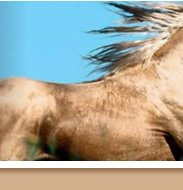![]()
![]()
![]()
![]()
![]()
![]()

![]()
![]()
![]()
![]()
![]()
Ask the Experts: Rider Who Pumps with the Upper BodyA trainer, teacher and accomplished dressage competitor advises how to correct pumping with the upper body at the canter. By Leigh Cochran Leigh Cochran Question: In my dressage lessons, I've been told that I pump with my upper body at the canter. What am I doing wrong, and what can I do to improve? Answer: Pumping occurs when your upper body rocks forward and backward in an exaggerated way as you follow your horse's movements. It's a fault I often see in riders. Pumping with the upper body also can come from an insecure seat. Some think that pumping with the upper body will achieve a stronger driving aid and a better seat, but just the opposite is true. A pumping upper body will actually place the rider consistently behind the movement of the horse, disturbing his balance. Pumping makes your back tense, causing a loss of the ability to follow your horse's movements in a supple manner. The result is that your aids become delayed and are delivered in a tense or ineffective manner to the horse. The harmony between horse and rider is disturbed and the overall picture of you and your horse is not pleasing. A rider who pumps may find herself compensating for being behind the movement by pulling backward with her hands, impairing the forward flow and quality of the horse's gait. In response to the delivery of your tense aids, your horse will not be relaxed, and he will stiffen his back and his gaits. In contrast, a correct seat is balanced and allows the rider to give efficient aids without disturbing her horse. To correct a pumping upper body, revisit the development of a correct seat and leg position at the halt. Look in a mirror or ask a person on the ground to check to see that when you sit in the saddle, you are able to draw a line from your shoulder to your hip and straight down to the back of your heel. Your leg needs to hang long and relaxed. Your seat must rest in the saddle in a relaxed manner, and you should feel both seat bones in the saddle. When the horse moves at the walk, trot or canter, your pelvis follows the movements smoothly while your upper body stays quiet, upright and balanced. To maintain this, your abdominal muscles and deep muscles of the lower back have to contract and relax rhythmically. This work only if your back is supple, not tense. Do not grip with your thigh muscles because this lifts you out of the saddle. Relax your leg muscles so that you can sit as deeply as possible in the saddle and follow your horse's movements. When your horse canters, allow his canter to "roll under" you. Think of how a merry-go-round horse at a fair rises up and down under your seat. If your back stays relaxed and your seat stays deep, you can feel similar movement in your own horse's back. Try to feel it at the walk first, then at the canter. If you find yourself losing your correct position at the canter, return to the walk, reestablish it and try again. Consider taking some longe lessons from your instructor. I recommend working without stirrups, too. This helps you develop your balance and feel for your horse's movements and allows you to focus on your seat and leg position without worrying about controlling the horse. Once you find and establish the correct balance and seat at the canter, you should not have a pumping problem, and you should see an overall improvement in your horse's gaits, too. |
![]()
![]()
ęCopyright 2025
Alhaja.net All rights reserved.
Unauthorized duplication in part or whole strictly prohibited by
international copyright law.
![]()



